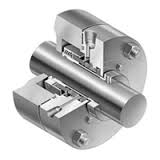Pusher Type Mechanical Seal
Pusher Type of Mechanical Seal

The pusher type of mechanical seals move axially along the rotating shaft or the sleeve to maintain the contact with the faces of the seal. This feature of these seals helps compensate for the wearing that may occur at the seal face, and wobbling due to misalignment. The pusher types of mechanical seals are used commonly, are less expensive and are easily available in the market in wide range of sizes and designs. The only disadvantage of these seals is that they tend to hang up and sometimes there is fretting of the shaft.
Pusher seals utilize a dynamic secondary seal which moves axially with the major seal face. which is either an o-ring, wedge or other type of equipment, across the shaft as a means of compensation for face wear and/or shaft movement.For high temperature (upto 500 deg.F) or aggressive chemicals a Teflon wedge ring may be used. Since Teflon is plastic and does not rebound like elastomer, it has to be pushed by spring force into the wedge shaped opening to maintain a seal on the shaft. Non-Pusher type or Bellow seals have no dynamic secondary seal under the movable seal ring. This makes them more flexible and better able to tolerate mating ring misalignment.
Features of pusher type Mechanical Seal:
Operation does not cause shaft wear.
Handle Bi-directional shaft rotation, large pressure, temperature and speed excursions.
Cannot handle axial end play.
Sealing faces must be finished smooth (0.08 to 0.4 micrometer) and can get easily damaged.
Non-pusher Type of Mechanical Seals:

Non-pusher seals have a static secondary seal which stays stationary against the shaft or sleeve. Metal bellow seal is its ability to run at a very high temperature (750 degF) if the elastomer ‘O’ rings are replaced with grafoil for the secondary seals. The use of bellow seal is limited to 400 PSI on OD.
In a bellows seal, the secondary sealing element (bellows) generally has a larger diameter than a pusher seal, therefore the closing area is less. Since the closing area is larger and the width of the primary ring face is limited (cannot be too large or it won’t fit in the bellows assembly), the balance ratio cannot be varied as much as in a pusher seal.









